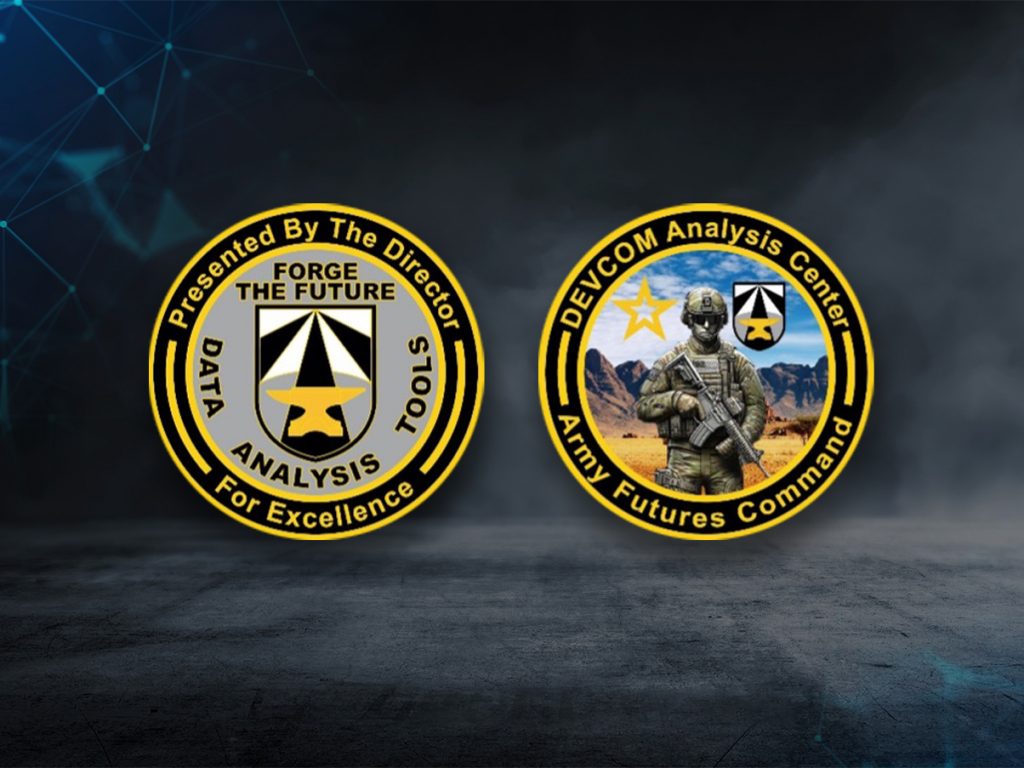DIG It: DAC’s Hartnett Awarded Patent for Revolutionary AI-Driven Dynamic InfoGraphic (DIG) Technology
September 23, 2024Angelica Casillas
FORT NOVOSEL, AL — Regina Hartnett, Ph.D., a research psychologist with the DEVCOM Analysis Center, has been awarded a patent for a groundbreaking technology designed to streamline battlefield data analysis through Dynamic InfoGraphics (DIG). This innovation promises to enhance Situational Awareness (SA), trust, workload and decision-making for Soldiers and Commanders alike.
Hartnett’s invention addresses the challenge of processing vast amounts of battlefield information collected by a plethora of sensors and the Internet of Battlefield Things (IoBT). “With Artificial Intelligence (AI), we can gather extensive data,” said Hartnett. “But the key is making relevant information more understandable and easily digestible for the user. Information is only valuable if it can be understood.”
The patented technology consists of three main components laid out in Harnett’s Model of DIGs Levels of SA (DIG LoSA) for intelligent agents like AI. First, is Sense and Display in which, raw data is transformed into graphical displays. Hartnett explained this concept using an analogy familiar to many: “Think about watching a football game. The bottom of the screen shows the score, time on the left, and other crucial stats in a compact format. Similarly, our technology displays critical battlefield information in a concise and accessible way, increasing SA while decreasing user workload.”
Second, is Transparency through EXplainable AI (XAI), in which the AI system provides explanations for its recommendations, enhancing trust in the agent and understanding among users. “Commanders need to trust the decisions or recommendations made by intelligent agents,” Hartnett noted. “By explaining which sensors or data points were used, we increase transparency and reliability which increases user SA and trust in the system.”
Last is Forecasting by Trend Analysis, in which the technology offers predictive insights based on trend analysis. “The AI forecasts potential future developments, such as enemy movements, based on historical data,” Hartnett added. This predictive capability allows for more proactive, informed and timely decision-making.
One of the significant benefits of Hartnett’s innovation is its adaptability to various roles within the military hierarchy. “A Commander and an E5 platoon sergeant have different information needs,” Hartnett explained. “The DIG concept is envisioned to customize the displayed data to match the user’s needs based on things like their role or position, permissions and preferences, ensuring relevance and efficiency.”
The practical applications of this technology are vast. While initially designed for Army aviation at Fort Novosel, it can be applied to any information needing to be digested by a human user. Including, Intelligence or Infantry for information such as spot reports, 9-Lines and MEDEVAC sites, enemy target information and locations, or weapon blast radius. Beyond military use, Hartnett envisions applications in other industries, such as automotive and medical fields. “Imagine an Augmented Reality (AR) DIG display in a car that provides real-time information to enhance safety and awareness, such as using AR that displays countdown timers for traffic lights or AR symbology to denote location in space for nearby gas stations with real-time gas prices or waiting times,” she says.
Hartnett’s work aligns with one of Army Aviation’s Future Vertical Lift requirements for Future Long Range Assault Aircraft (FLRAA) of ‘heads up and eyes out during degraded visual environments (DVE) for SA and obstacle detection.’ By integrating battlefield information into DIGs using AR, pilots can access crucial information without diverting their attention from outside the aircraft.
Dr. Harnett was recognized by AFC for the development of DIG to enhance Soldier situation awareness at the “speed of battle” and awarded the Major General Green Innovation Award -Individual, presented by GEN Rainey in January 2023. In addition to the Army acknowledging the significance of the DIG concept patent for her innovation, the Army transitioned the concept to the DoD R&D community as well as industry by granting a Patent License Agreement (PLA) for commercial sales via Department of the Interior and transitioned DIG to the Technology Transfer Program; Strategic Partnership Office and Techlink Marketing.
The journey to this innovation began with a simple observation. “Watching a football game, I realized how quickly I could understand the game’s status from the unobtrusive, information filled, on-screen graphics,” Hartnett recalled. “I thought, why can’t we make it that easy for our Soldiers on the battlefield?”
Automating and simplifying data collection, analysis, and display with AI not only reduces the risk for soldiers but also significantly improves their situational awareness if displayed appropriately. This patent represents a significant advancement in military technology, offering a practical solution to managing and understanding the increasing volume of battlefield data. As AI continues to evolve, innovations like Hartnett’s DIG technology will be crucial in maintaining a strategic edge and that is something that we can all ‘DIG.’

As one of the eight U.S. Army Combat Capabilities Development Command (DEVCOM) Centers and a subordinate of the U.S. Army Futures Command, The (DEVCOM) Analysis Center (DAC) informs Army transformation and readiness decisions across the system’s life cycle through objective integrated system-level Analysis, and the development of credible Data and Analytic Tools. DAC is one of eight Centers and Labs within DEVCOM. Visit the DEVCOM website for more information.


